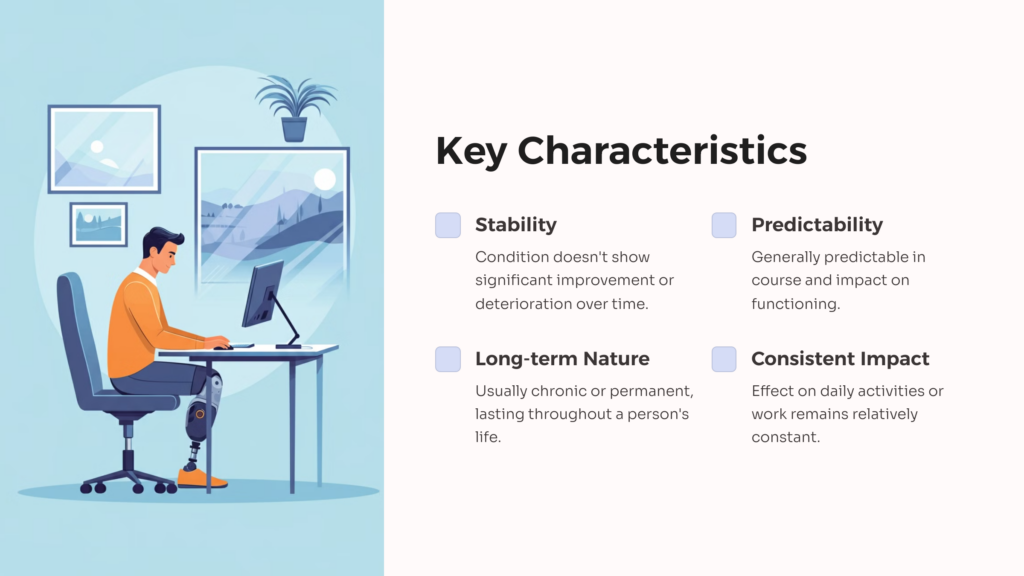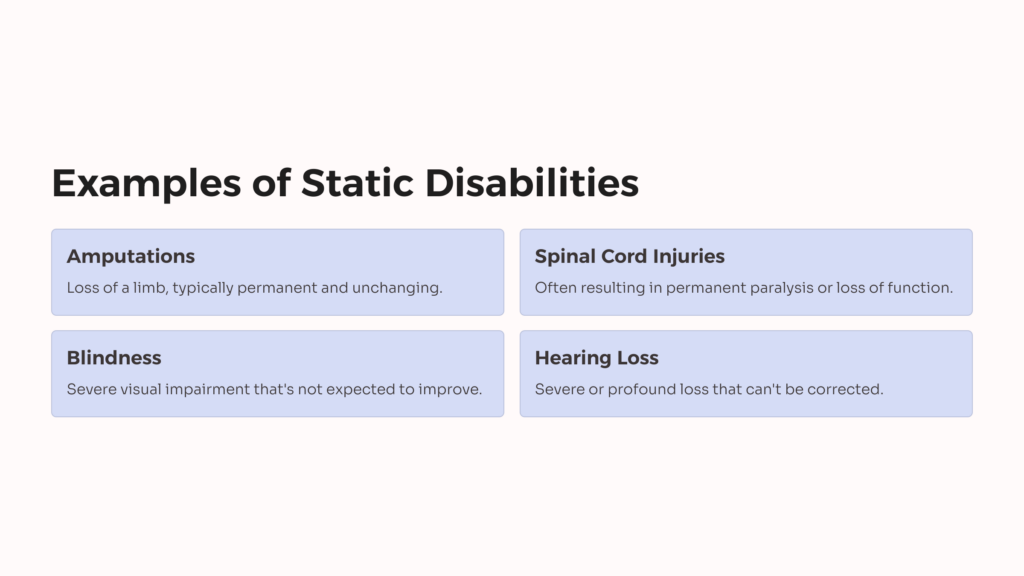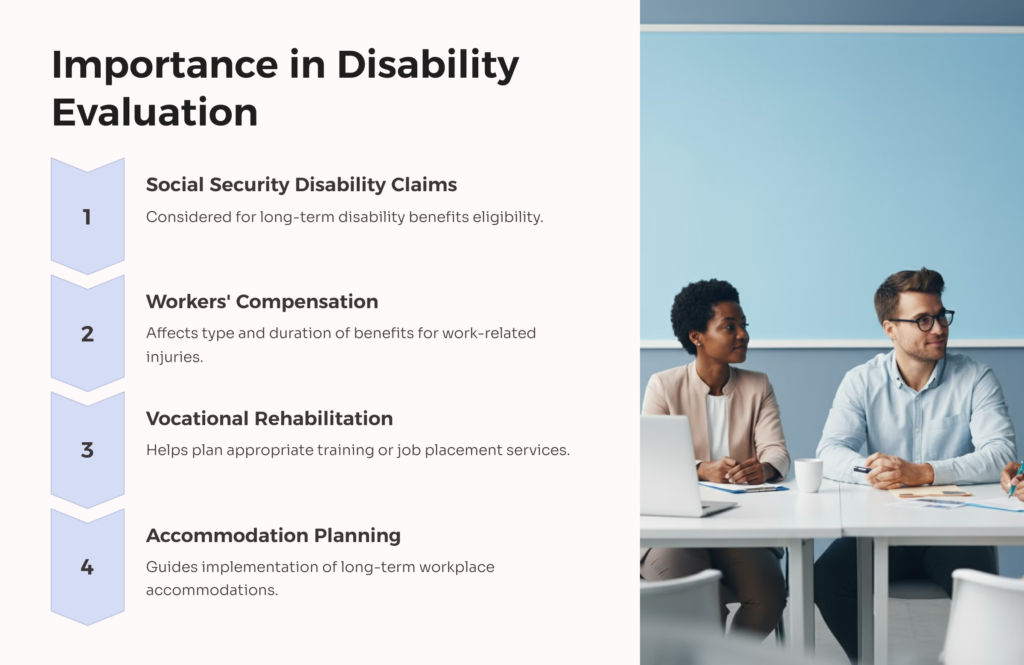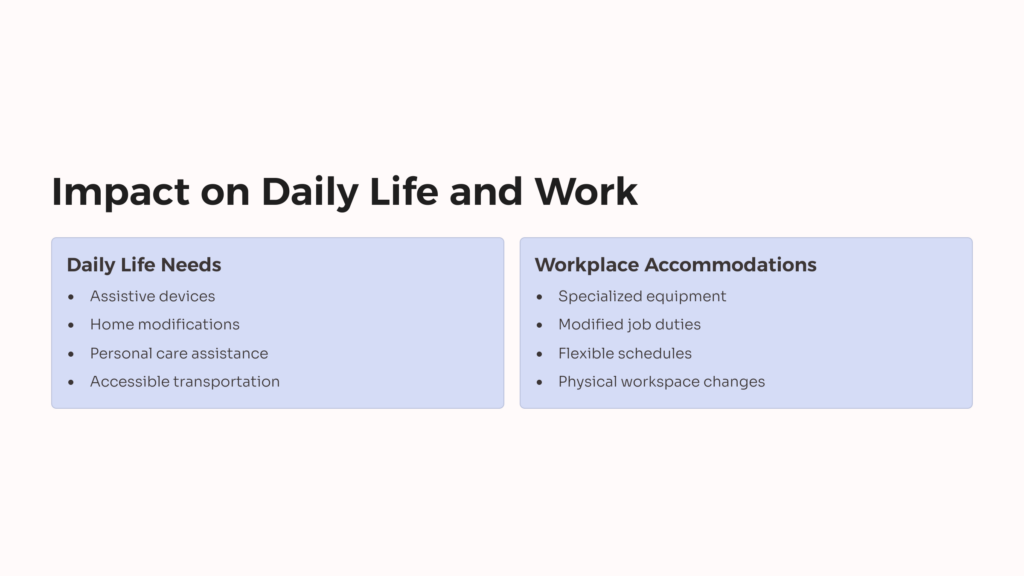Static disability is a term used in the field of disability assessment and benefits. It refers to a medical condition or impairment that is unlikely to change significantly over time. This type of disability is considered stable, meaning the person’s ability to function or work is not expected to improve or worsen substantially.
When a person has a static disability, their condition is usually permanent or long-lasting. This doesn’t mean the disability can’t change at all, but any changes are typically minor and don’t affect the overall impact on the person’s life or work ability.
Understanding static disability is important for both individuals with disabilities and those involved in disability evaluation processes. It helps determine appropriate support, benefits, and accommodations for the affected person.
Characteristics of Static Disabilities

Static disabilities have several key features that set them apart from other types of impairments. These characteristics help medical professionals and disability evaluators assess and classify conditions accurately.
- Stability: The most defining feature of a static disability is its stability over time. The condition doesn’t show significant improvement or deterioration.
- Predictability: Static disabilities are generally predictable in their course and impact on a person’s functioning.
- Long-term nature: These disabilities are usually chronic or permanent, lasting for an extended period or throughout a person’s life.
- Consistent impact: The effect on a person’s ability to perform daily activities or work remains relatively constant.
Understanding these characteristics is crucial for proper disability management and support planning.
Examples of Static Disabilities

Static disabilities can encompass a wide range of conditions. Here are some common examples:
- Amputations: The loss of a limb is typically considered a static disability as the condition is permanent and unlikely to change significantly.
- Spinal cord injuries: Many spinal cord injuries result in permanent paralysis or loss of function, classifying them as static disabilities.
- Blindness or severe visual impairment: When vision loss is permanent and not expected to improve, it’s often categorized as a static disability.
- Hearing loss: Severe or profound hearing loss that can’t be corrected with treatment or devices is usually considered static.
- Certain neurological conditions: Some brain injuries or congenital neurological disorders may result in static disabilities.
These examples illustrate the diverse nature of static disabilities and their long-term impact on individuals’ lives.
Static vs. Dynamic Disabilities
To better understand static disabilities, it’s helpful to compare them with dynamic disabilities. The main difference lies in the potential for change over time.
Static disabilities:
- Remain relatively stable
- Have a consistent impact on functioning
- Require long-term management strategies
Dynamic disabilities:
- Can improve or worsen over time
- May have fluctuating effects on a person’s abilities
- Often need ongoing assessment and adjustments to treatment
Examples of dynamic disabilities include some mental health conditions, certain progressive diseases, and injuries that have the potential for recovery or rehabilitation.
Understanding this distinction is crucial for proper disability assessment, treatment planning, and benefit determination.
Importance in Disability Evaluation

The concept of static disability plays a significant role in disability evaluation processes. It’s particularly important in areas such as:
- Social Security Disability claims: The Social Security Administration considers whether a condition is static when determining eligibility for long-term disability benefits.
- Workers’ compensation: In cases of work-related injuries, identifying a disability as static can affect the type and duration of benefits provided.
- Vocational rehabilitation: Understanding whether a disability is static helps in planning appropriate vocational training or job placement services.
- Accommodation planning: Employers use this information to implement suitable long-term workplace accommodations.
Accurate classification of a disability as static or dynamic ensures that individuals receive appropriate support and resources tailored to their specific needs.
Impact on Daily Life and Work

Static disabilities can have profound effects on a person’s daily life and work capabilities. These impacts are typically long-lasting and require ongoing adaptations.
In daily life, individuals with static disabilities may need:
- Assistive devices or technologies
- Home modifications
- Personal care assistance
- Accessible transportation options
In the workplace, accommodations might include:
- Specialized equipment or software
- Modification of job duties
- Flexible work schedules
- Physical changes to the work environment
Despite these challenges, many people with static disabilities lead fulfilling lives and successful careers with proper support and accommodations.
Management and Support Strategies
Managing a static disability involves developing long-term strategies to maximize independence and quality of life. Here are some key approaches:
- Medical management: Regular check-ups and maintenance therapies to prevent complications.
- Assistive technology: Utilizing devices and tools designed to enhance function and independence.
- Lifestyle adaptations: Modifying daily routines and environments to accommodate the disability.
- Psychological support: Addressing the emotional and mental health aspects of living with a permanent disability.
- Community resources: Accessing support groups, disability services, and advocacy organizations.
- Vocational training: Developing new skills or adapting existing ones for suitable employment.
These strategies help individuals with static disabilities maintain their health, independence, and overall well-being.
Legal Considerations and Rights
Individuals with static disabilities have specific legal rights and protections. Understanding these is crucial for ensuring fair treatment and access to necessary resources.
Key legal considerations include:
- Americans with Disabilities Act (ADA): Prohibits discrimination and ensures equal opportunities in employment, public accommodations, and other areas.
- Social Security Disability Insurance (SSDI): Provides financial support for those unable to work due to long-term disabilities.
- Workplace accommodations: Employers are required to provide reasonable accommodations for employees with disabilities.
- Education rights: Laws like the Individuals with Disabilities Education Act (IDEA) ensure access to appropriate education for students with disabilities.
- Housing rights: Fair housing laws protect individuals with disabilities from discrimination in housing.
Being aware of these legal protections empowers individuals with static disabilities to advocate for their rights and access necessary support services.
Advancements in Treatment and Technology
While static disabilities are generally stable, advancements in medical treatment and assistive technology continue to improve the lives of those affected. These developments can enhance function, independence, and quality of life.
Some notable advancements include:
- Prosthetic limbs with advanced functionality
- Brain-computer interfaces for communication
- Exoskeletons for mobility assistance
- Gene therapies for certain genetic conditions
- Stem cell treatments for spinal cord injuries
While these innovations may not cure static disabilities, they can significantly improve the ability of individuals to navigate daily life and participate more fully in society.
Living with a static disability presents unique challenges, but it also offers opportunities for personal growth, resilience, and adaptation. With proper support, resources, and a positive mindset, individuals with static disabilities can lead fulfilling lives and make valuable contributions to their communities.
For veterans in particular, receiving the best possible care and the VA disability rating that makes the most sense is essential. We at AllVeteran.com are here to help you. Take our free medical evidence screening and start today.
 AllVeteran.com Advisors
AllVeteran.com Advisors
With expertise spanning local, state, and federal benefit programs, our team is dedicated to guiding individuals towards the perfect program tailored to their unique circumstances.











